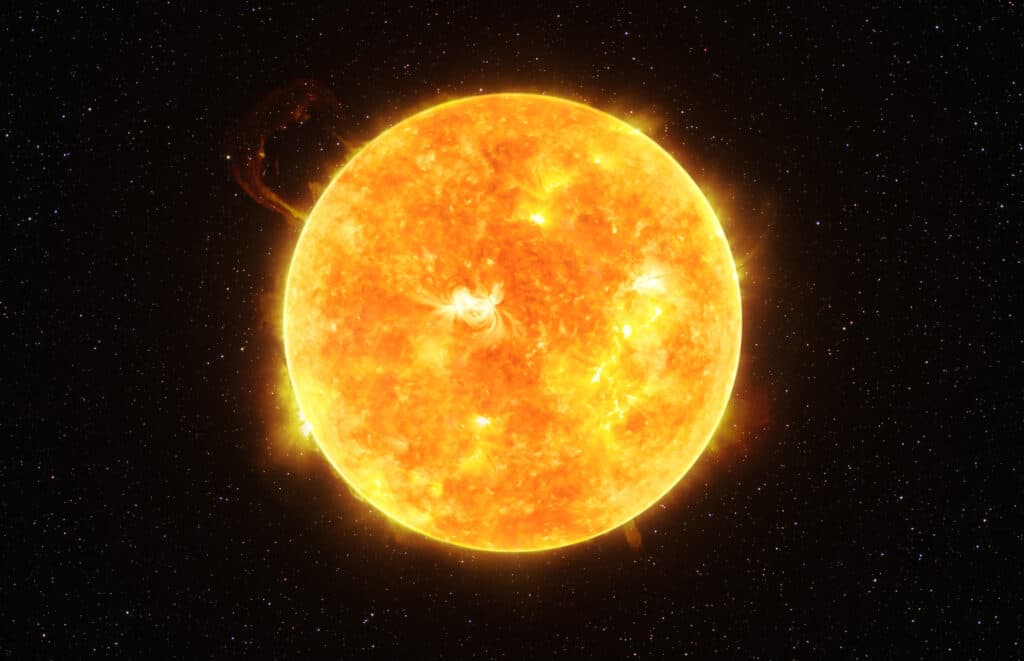We’ve all looked up into the sky, eyes averted just enough to preserve our vision, to look in wonder at the glowing orb in the sky that powers everything on our planet. But, have you ever asked the question: just how hot is the sun? The sun is one of the hottest celestial bodies in the universe. In fact, it’s so hot that nothing liquid or even solid can even exist on its “surface.”
Here, we’ll find out why you’ll never be able to land on the sun. We’ll discover just how this enormous ball of light gets its energy, and what produces its light. First, we’ll learn about the sun’s layers from the inside out and discover that not every part of the sun is as hot as the rest. Finally, we’ll answer the big question: how hot is the sun?
Just What is the Sun?

Lukasz Pawel Szczepanski/Shutterstock.com
The sun is a star. But, it’s not just any star: it’s a yellow dwarf star, officially classified as a G2 V star. A G2 star is one that ranks as the second hottest type of star in the G class. The sun sits at the center of the solar system; it’s a whopping 93 million miles away from the Earth. Further, the sun is 4.5 billion years old and comprises over 99% of the mass in the solar system. Its radius is 109 times bigger than the Earth’s, and it weighs about 330,000 times the weight of our planet.
The Sun: Layered Like an Onion
When you’re asking the question: how hot is the sun?, it’s important to recognize that not every part of the sun is as hot as the next. In fact, the sun is made up of distinct body and atmospheric layers. Much like the layers of the Earth, the sun’s layers each have their own specific makeup and average heat. Altogether, they emit heat and light in a near at a near-constant rate called the solar constant. Without the solar constant, there would be no life on Earth.
1. The Core
The core is where it all happens. Located at the center of the sun, the core is subject to monumental forces of gravity. This gravity creates extreme pressure. That pressure is actually so high that it causes the hydrogen atoms in the core to collide with one another. These collisions are so forceful that they actually create a new element: helium. This process is called nuclear fusion, and it’s where all the heat and light in our solar system come from.
The temperature of the sun’s core is 27,000,000 degrees Fahrenheit. This is the hottest part of the sun, from here, all that heat radiates outward. Eventually, it reaches us in the form of light and warmth from the sky.
2. The Radiative Zone
Each layer has a different temperature. The radiative zone, the layer that surrounds the core, runs about 7-12 million degrees Fahrenheit nearest the core. The outer part of this zone is closer to 2-4 million degrees Fahrenheit.
3. The Convection Zone
The final layer that makes up the body of the sun is the convection layer. This layer is made up of plasma, which is so hot it continuously bubbles up to the “surface.” The convection zone sits around 4 million degrees Fahrenheit; as the plasma bubbles outward, it transfers heat to the sun’s “surface.” However, the surface of the sun is made up primarily of plasma; no liquids or solids can exist there because of the extreme heat.
The Sun’s Atmospheric Layers
The temperature of the sun’s core is 27,000,000 degrees Fahrenheit. The sun’s surface temperature is about 10,000 degrees Fahrenheit. Beyond the surface, the sun’s atmosphere has three distinct layers: the photosphere, the chromosphere, and the corona. Let’s take a look at all three to help us answer the question: how hot is the sun?
1. The Photosphere
The photosphere is the first layer of the sun’s atmosphere. Sitting closest to the surface, this is the layer that produces the light we see in the daytime. Since it’s at the surface, the temperature of the photosphere is around 10,000 degrees Fahrenheit. Further, the photosphere is where sunspots occur. Sunspots are cool spots within the photosphere; they emit less light than hotter spots, which gives them a darker appearance.
2. The Chromosphere
To know how hot the sun is, you have to travel outwards from the sun’s plasma surface, beyond the photosphere, to the chromosphere. The chromosphere is the second layer of the sun’s atmosphere; it stretches up to 200 miles above the plasma surface. The chromosphere ranges in temperature from 7,200-11,000 degrees Fahrenheit.
3. The Corona
The corona is perhaps the most visually stunning part of the sun. This atmospheric layer extends thousands of miles beyond the plasma surface. It’s the bright ring of light you see when you look at the solar eclipse. Based on the principle of radiative heat, and the fact that the sun’s core is its hottest part, you might expect the corona to be the coolest part of the sun.
In fact, it’s the opposite. For reasons that scientists still don’t understand, the corona is a whopping 1.8 million degrees Fahrenheit. So, in addition to not being cooler than the photosphere and the chromosphere, the corona is actually the hottest part of the sun’s atmosphere.
Up Next
How Far Away from the Sun, and Other Planets, is Earth?
How Much Energy Does the Sun Produce?
The post How Hot Is The Sun (Surface, and Core) In Fahrenheit? appeared first on AZ Animals.
from Animal News, Facts, Rankings, and More! - AZ Animals https://ift.tt/UnzuAhr